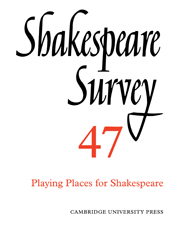Book contents
- Frontmatter
- Shakespeare Played Small: Three Speculations about the Body
- The Architecture of the Fortune Playhouse
- The Bare Island
- ‘How Chances it they Travel?’ Provincial Touring, Playing Places, and the King’s Men
- Writing for the Metropolis: Illegitimate Performances of Shakespeare in Early Nineteenth-Century London
- The Perishable Body of the Unpoetic: A. C. Bradley Performs Othello
- Playing Places for Shakespeare: The Maddermarket Theatre, Norwich
- ‘A Fairly Average Sort of Place’: Shakespeare in Northampton, 1927–1987
- The Living Monument: Self and Stage in the Criticism and Scholarship of M. C. Bradbrook
- Stratford Stages: Interviews with Michael Reardon and Tim Furby, and Sam Mendes
- Dis-Covering the Female Body: Erotic Exploration in Elizabethan Poetry
- Theseus’ Shadows in A Midsummer Night’s Dream
- ‘Time for Such a Word’: Verbal Echoing in Macbeth
- Shakespeare’s Knowledge of Italian
- Tamburline and Edward Alleyn’s Ring
- Shakespeare Performances in England, 1992–1993
- Professional Shakespeare Productions in the British Isles, January-December 1992
- The Year's Contributions to Shakespeare Studies 1 Critical Studies
- 2 Shakespeare’s Life, Times, and Stage
- 3 Editions and Textual Studies
- Books Received
- Index
Dis-Covering the Female Body: Erotic Exploration in Elizabethan Poetry
Published online by Cambridge University Press: 28 March 2007
- Frontmatter
- Shakespeare Played Small: Three Speculations about the Body
- The Architecture of the Fortune Playhouse
- The Bare Island
- ‘How Chances it they Travel?’ Provincial Touring, Playing Places, and the King’s Men
- Writing for the Metropolis: Illegitimate Performances of Shakespeare in Early Nineteenth-Century London
- The Perishable Body of the Unpoetic: A. C. Bradley Performs Othello
- Playing Places for Shakespeare: The Maddermarket Theatre, Norwich
- ‘A Fairly Average Sort of Place’: Shakespeare in Northampton, 1927–1987
- The Living Monument: Self and Stage in the Criticism and Scholarship of M. C. Bradbrook
- Stratford Stages: Interviews with Michael Reardon and Tim Furby, and Sam Mendes
- Dis-Covering the Female Body: Erotic Exploration in Elizabethan Poetry
- Theseus’ Shadows in A Midsummer Night’s Dream
- ‘Time for Such a Word’: Verbal Echoing in Macbeth
- Shakespeare’s Knowledge of Italian
- Tamburline and Edward Alleyn’s Ring
- Shakespeare Performances in England, 1992–1993
- Professional Shakespeare Productions in the British Isles, January-December 1992
- The Year's Contributions to Shakespeare Studies 1 Critical Studies
- 2 Shakespeare’s Life, Times, and Stage
- 3 Editions and Textual Studies
- Books Received
- Index
Summary
Yet Ovid's wanton Muse did not offend: He is the fountain whence my streams do flow; Forgive me if I speak as I was taught . . .
(Thomas Nashe, The Choice of Valentines)The first and, arguably, greatest Elizabethan 'bed-scene' takes place in the last hundred lines of Marlowe's Hero and Leander (2.235-334). By physically staging the drama of lust-in-action, the great literary pioneer engages in a highly original dialogue with classical tradition, and in a feat of poetic trail-blazing. Surprisingly enough, the literary origins and techniques of this memorable scene, as well as its impact on the Elizabethan erotic imagination, do not seem to have aroused much critical interest. Judging from this neglect, the representation of the body in sensuously inviting intimacy appears to be a more disreputable topic in Renaissance literature than in the fine arts of the period. Thus in what is probably the most influential treatment of Hero and Leander, the corruption of 'the Greek maiden of Musaeus' by the 'fleshliness of the Amores' is being emphatically deplored: 'One wonders what miracle Marlowe might have achieved if he had been able to approach Musaeus directly.' One wonders.
Unlike Renaissance painting, Elizabethan poetry in the 1580s had not yet discovered the lure of the body. It was Marlowe who led the way, and in doing so he proved the brilliantly gifted pupil of his magister amoris Ovid, whose love poems he had formerly translated line by line.
- Type
- Chapter
- Information
- Shakespeare Survey , pp. 127 - 138Publisher: Cambridge University PressPrint publication year: 1994
- 2
- Cited by

